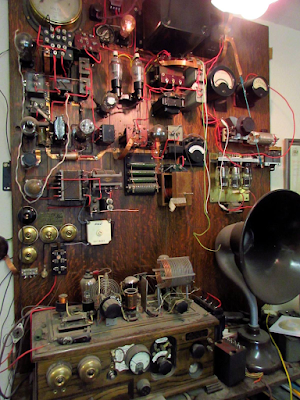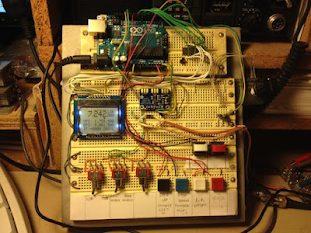Thanks Charlie! Be sure to check out the rest of his YouTube channel: https://www.youtube.com/@CharlieMorrisZL2CTM
Serving the worldwide community of radio-electronic homebrewers. Providing blog support to the SolderSmoke podcast: http://soldersmoke.com
Podcasting since 2005! Listen to Latest SolderSmoke
Thursday, May 23, 2024
Charlie ZL2CTM's New Receiver
Wednesday, May 22, 2024
Rigs on Vertical Boards -- Then and Now
Tuesday, May 21, 2024
Laser Communication in London 2007 -- a Pointer, a VW Solar Panel, and Radio Kismet
Friday, May 17, 2024
Band Imaging Rigs (Receivers and Transceivers) -- Video from WA7MLH
Thursday, May 16, 2024
A Light-beam QSO in Hollandia, Christmas 1944
Christmas, 1944
In a wartime world the singular and exclusive camaraderie that exists in the hobby of amateur radio results in so many unexpected and coincidental meetings between good friends, who have previously never seen each other, as to make such happenstance fairly commonplace. But I boast a tale in which time, place and circumstance combined to cause a similar occurrence to be most extraordinary.
The Liberty ship El Segundo Ruiz Belvis lay at anchor in the murky waters of Humbolt Bay, New Guinea, on a tepid tropical night in '44. In the absence of the moon, the Dipper and the Southern Cross scintillated bewitchingly. On the shore, the lights of the army base of Hollandia burned steadily in contrast to the varipowered signal blinkers which intermittently pieced the opaque darkness throughout the harbor. The latter were visual communication between ships and shore plus an admixture of ship-to-ship chatter, official and otherwise. There was an underlying tense tinge to the atmosphere and the stillness was broken only by the sharp staccato of the Belvis' blinker shutters as the signalman transacted port business with the powerful land station.
This was rendezvous. Our Liberty, with scores of army personnel aboard, had here become a unit in the formation of a huge convoy. Crammed into holds, on hatches and into every available nook and cranny of the steel deck, we were Leyte-bound. Stifled, sweaty and hungry on our two meals per day, we wore out deck after deck of pinochle cards and read every available piece of literature over and over again. It was almost a month since we had left Sansapor, scene of our last operation. We were exuberant in the knowledge that we were soon to leave New Guinea.
Christmas was but a few days away and we had had no mail for weeks. Men leaned languidly on the rail and thought of home while others dreamed of the same in their cramped quarters. The circumstances certainly made this Yuletide one to be long remembered. Nevertheless, all that would feature this day for us would be a possible piece of priceless turkey added to the usual dehydrated viands. Just another dragging equatorial day to be piled atop hundreds of others like it.
It was ten o'clock. I was wide awake; only my eyes were tired. Presently, I found myself detachedly reading the blinkers which poked their focused fingers indiscriminately about the bay. My quarters, in the cab of a 399, were on the port rail amidships and afforded a good view across the water. I became absorbed in various bits of chatter between nearby vessels. It struck me that QRM was quite heavy tonight—a sort of an optical 80 meters. I saw one of the lights sign off with a "73." This was interesting as among the host of merchant marine signalmen, hams are spread pretty thinly. I seized my M-1 torch and focused an insipid beam in the direction of that ship. I sent CQ CQ CQ K. A ham call sign is a cumbersome thing to handle with a blinker. Furthermore, I had no faith in the DX powers of my 3-volt flashlight bulb. I was therefore elated when a bright interrogatory sign beamed forth, aimed obviously in my direction. Contact! True, it was outside the hambands, but band divisions in the microwave region are indefinite anyway.
I was still dubious as to whether my man was an amateur. Rather than complicate matters immediately, at this speed of 8 words per minute, I began in the language of the layman: HELLO PAL WHERE YOU FROM? K. Back in an agreeably rhythmic style came: R TULSA OKLA NAME IS HAL K. The given name and place struck a subconscious inner chord vaguely. Next, I blinked: GE HAL IM ROD FROM CHGO K. There was a pause. He reoriented his beam to compensate for tidal drift and then startled me with: W9BRD DE W5EGA K.
The night quickly took on an exhilarant aspect as we lapsed into ham vernacular, spiced with many Morse slaps on the back. Hal Frank was no other than an old c.w. crony of mine. We had heckled each other on 80, 40 and 20 a countless number of times in the prewar days. In memory I was hearing again that beautiful swing and T9X sledge-hammer signal off his three-element rotary. We discovered mutual ham friends and we exchanged much welcome information and recounted bygone days. He was quite amazed to learn that I was behind a mere GI flashlight (with low batteries at that). The QSO continued far into the night—the next and the next.
We seemed destined to rot in our anchorage. The convoy movement was postponed from day to day. However, this Christmas season took on a much different aspect for me as arrangements were made and, at 0900 Christmas Day, my friend, Wilbur Kuure, W9YNY, and I debarked unsteadily down the ladder and made our way across an undulating swell to the Liberty ship Chittenden. There, we met Lt. Hal Frank, W5EGA, personally, for the first time. We all agreed that it was quite a small and bizarre world that December 25th.
Verbal reminiscences cluttered the air within W5EGA's exceedingly neat cabin for several hours. Shelves in his quarters were lined with excellent reading material including many late QSTs. Compared to our situation aboard the Belvis, Kuure and I thought this a bit of heaven.
We were thoroughly acquainted by the time we appeared in the officers' mess. As the cuisine took shape before us and disappeared into our eager gullets, my army pal and I felt somewhat sorry for our less fortunate buddies on the home ship. But such is life. We had, in nautical terms, a "Little Roundhouse," consisting of a generous helping of everything on the menu. We swept our plates clean to Hal's amusement. I remember, most distinctly, the dessert of apple pie and ice cream.
Nightfall found Kuure and me "back to earth" on the Belvis after a most delightful Christmas Day. According to plan, we blinked a "goodnight and thank you" to W5EGA through the twilight. That was our last QSO of that series. Not long after that we weighed anchor and headed for our next stop on the long road back home. Our holiday was over, a new year had begun and there was still a war to be won.
| From S/Sgt. R. H. Newkirk, W9BRD, "Christmas, 1944" QST, January 1946, pages 25 and 102. |
Wednesday, May 15, 2024
CuriousMarc Looks at Phase-Locked Loops (PLL)
Monday, May 13, 2024
Ragnar LA1UH's Wonderful Museums in Norway
Saturday, May 11, 2024
Jens OZ1GEO's AMAZING Radio Museum
Helge SM/LA6NCA Activates Colorburst Liberation Army in Sweden!
Friday, May 10, 2024
Wednesday, May 8, 2024
Why we have "BW Limit" Switches on our Oscilloscopes
Dean KK4DAS asked me why we have these switches on our 'scopes. I didn't know. Dean asked Alan Wolke W2AEW. Alan knew:
Alan Wolke wrote:
Interesting background on the 20MHz vertical BW selection. This feature has existed on the vast majority of all oscilloscopes since the 50s or 60s (both analog & digital). When I explored the history of this, I spoke to some of the folks at VintageTek.org, and wound up having a chat with THE engineer that did it first! Tt was John Addis, designer at Tektronix.
At the time, Tektronix was located in Portland Oregon. While working on a wideband vertical preamp for a new scope (the 7A11 vertical plugin for the 7000 series scope), John Addis was plagued with interference from the local television broadcast station in the 50MHz band. So, he popped in a 20MHz low pass filter that he could switch in/out so that he could complete the work on the preamp. Since it was deemed useful, it was left in the design.
And, since Tektronix added a switchable 20MHz low pass filter in their scope, and Tek was the leader in oscilloscope technology, other manufacturers followed suit, and this feature has "stuck" as a staple in vertical setting controls.
The main reasons you'd use this filter would be to improve the signal to noise ratio (SNR) for signals when their frequency content is below 20MHz. You've probably noticed that, even without any signal connected, the thickness of the trace is thinner when you engage the 20MHz filter.
---------------------
Alan sent a link to a Wiki page about the 7A11 that John Addis was designing. Alan says this places the initial inclusion of the 20 MHz BW Limit filter to the mid 1960s:
https://w140.com/tekwiki/wiki/7A11.
Thanks Dean, thanks Alan!
Saturday, May 4, 2024
W4YWA's Homebrew Rig on 20 Meters
Ed W4YWA is far too modest -- he has built a very FB homewbrew transmitter. Congratulations Ed. I think your original plan to use a Web SDR receiver will work, if you and the other station are just willing to pause for an additional second or two to let the internet catch up with the real world. Also, you might find some Web SDRs that have less latency than other. You could used a little SW receiver or a simple buzzer for your sidetone ( I think sidetone is your most pressing latency concern.) My suggestion is to try to get a few contacts using the Web SDR (perhaps via schedule -- try the DX Summit or the SKCC web page to set some up). Then build yourself a simple Direct Conversion receiver to use with this rig. You don't have to try to build a VFO at 14 MHz (that can be difficult) -- you could build one at 7 MHz (use the circuit from our High School receiver project) and pair it up with a "Subharmonic Mixer" so that you can tune the 20 meter band. Please keep us posted on your progress.
Ed writes:
Home-Brew Fun and Failures










